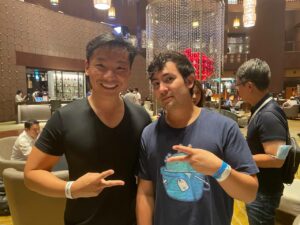Jeff ‘Jiho’ Zirlin, cofounder of Axie Infinity and Sky Mavis “discovered” crypto many times without diving in completely.
What finally changed his mind?
The answer is CryptoKitties, something that Jiho mentioned on the Beacon Podcast series Web3 Unlocked, was at the intersection of all the things that he found interesting. In this episode, I talk to Jiho about his Web3 journey, founding Sky Mavis, and how Web3 founders can turn their communities into evangelists for sustained growth.

Getting Started With Web3 And Early Days of Axie Infinity
At Yale, Jiho was a military and economic history major, aiming to become a trader and investor. The first time he heard about crypto was when his friends suggested he could drop out and join them to start a crypto fund, which he turned down.
The second time he got interested was during the 2012–2013 Cypriot financial crisis, when the government chose to take money from the people’s bank accounts to pay its sovereign debt. This sparked a desire to learn about a financial system in which sovereign powers didn’t dictate things.
In 2017, he would discover CryptoKitties, which was an intersection of everything that excited him: gaming, genetics, and collecting.
“I spent so much of my life compartmentalizing my passions and my education and my career. And I think that was something that Web3 allowed me: to stop trying to be a different person when you’re pursuing your passions and when you’re pursuing your professional journey. I got into Web3 because I saw it as a new market, the first new market that I ever identified, where I could be an entrepreneur, and it would be at the intersection of my hobbies.”
As part of the CryptoKitties community, he would meet other future builders, including his future Axie Infinity co-founders. Axie initially came about when the founders wanted to build something nostalgic, like the games we grew up playing like Pokemon, Tamagotchi, and Neopets. .
They wanted to build a Web3 community that would reward those with the technical knowledge and those willing to learn about the technology. He perfectly sums up their founding principle: “Something that can play into childhood nostalgia is going to be a compelling way to educate people on Web3.”
Axie Infinity launched during the crypto winter of 2018. Reflecting on those early days, Jiho notes, “We toiled and built-in relative obscurity for a long time.”
This meant days of meeting people and explaining Axie’s purpose until Jiho lost his voice. But the team was confident and they had a mission. Tuning into his own experience of getting into crypto, Jiho emphasized that they needed ‘everyday people’:
“If we’re gonna reward technical people, let’s also reward everyday people for trying out and learning about the technology suite of products.”
Challenges Axie Had To Overcome
Jiho cites two major challenges Axie Infinity had to overcome back then to become successful. The first was setting expectations instead of agreements, especially when it came to laying out the road map. As Jiho notes, with the game, they were trying something new that had not been done before, so most of their implementations were experimental.
“All problems in relationships come from expectations where both parties don’t understand there are certain expectations that are projected by the other party. For us, we would put out roadmaps, but we would not say this is experimental or subject to change as we learn more, and community members would be like you said you would do this and this at this time…. So, relationship management around the agreement of the roadmap was something that was very difficult for us in the early days.”
By setting the roadmap without communicating with the Axie community on what they could expect to be achieved, they found themselves in a pickle for failing to meet some milestones. The other issue was scalability.
Back then, few protocols were engaged in solving the scalability issue. After experimenting with the Loom network, it became clear they didn’t want to build their startup on another startup. The team learned about the product requirements and challenges of launching a blockchain game. And this is how the Ronin Network, a scaling sidechain, was born:
“We decided, nobody is going to build this better than us because we’ve actually gone through the process of launching this thing. That was where Ronin came from: solving a clear problem that we had and then deciding to build our own Web3 gaming infrastructure–which is how we’ve observed many key infrastructures being built over time, especially around gaming.”
Creating A Culture Of Resilience And Openness
In its 5+ years of existence, Axie Infinity has had to overcome many challenges that could have killed the project. Jiho is quite proud of how the project has managed to bounce back from each setback and get stronger.
It’s an attribute that is quite appealing to the Axie community, and one of the two that makes them stick around.
“We have badges of honor when it comes to surviving nearly existential events. We have almost died many times, and we are like Goku, right? I tend to think of us like Saiyan because every time we almost die, we come back freaking stronger and go to the next level.”
In March 2022, North Korean hackers breached the Ronin Bridge, managing to steal over $600 million in network assets. However, the protocol was able to recover all the funds and get back on its feet.
The other aspect, according to Jiho, is caring. As he puts it, “if you care, you will get better over time.” This is reflected in how the project has maintained open communication with its community, thus managing sentiment and expectations.
This culture of openness from day one, I believe, is what makes a big difference between a Web2 and Web3 founder mentality. Because Web3 founders build with the community, the latter accept failures and stick with the product–and I believe Jiho’s experience as a community manager helps to communicate and engage with the Axie community effectively.
As Jiho puts it, having unified messaging is the key to Web3 growth.
How Web3 Founders Can Leverage Their Communities To Evangelize Projects
Crypto startups have a significantly lower success rate compared to their counterparts in other industries. A 2023 report by Embroker notes that only 10% of crypto startups succeed, compared to 25% of startups in other industries. One of the reasons for this is the significantly smaller pool of users to onboard–but Axie Infinity is changing that.
Jiho and his team at Sky Marvis have managed to make Axie Infinity one of the largest Play2Earn games that has onboarded millions of users onto the blockchain. At its peak, Axie Infinity had almost 3 million daily users. The game became a hit in developing nations as players turned to it to feed themselves.
Part of their success came from turning their community into evangelists for the project. Jiho notes that members of the community need to articulate that they are a “nation.” To get these individuals thinking this way, there is a need for aligned incentives.
In the Sky Mavis case, the Axie Infinity and Ronin communities had to be united as one through aligned incentives. When Ronin was launched, its tokens were only accessible through Axie and SLP tokens.
He goes on to add that nations also need cultures such as art, sports, and media. In Axie’s case, there is NFT art that can be traded. Also, the game can be seen as a competitive sport that exists within the Lunacian nation. Moreover, there are various media channels, some of which are not even directly linked to the project but are key to establishing the culture and controlling information flow, which is key to the coordination of the entire community. These include community podcasts, newsletters, chats, and more.
Eventually, it all comes down to learning how to distribute information and coordinate behavior.
What Axie Infinity Is Doing to Onboard New Users
“We’re the only NFT project that I’m aware of that’s onboarding millions of people to crypto. And you know, that we’re also in the Guinness Book of World Records: Axie is the number one NFT project by all time volume–$4.2 billion in lifetime transaction volume”
So how is Axie doing what most Web3 projects are unable to do?
Jiho tells me it’s because they have thought about and created unique benefits that are only enabled by Web3, to get people to share it with their family and friends. It goes back to their founding idea of creating something like Pokemon or Tamagotchi, to create something people can relate to.
Much of it was speculative in nature, some of it worked, some of it did not.
And this was the idea behind launching on Google’s Play Store and Apple’s App Store:
“You can onboard your friends and family, have them fall in love with the game before actually having them go through the Web3 onboarding aspect of the game. At its core, it showed that these Web3 applications can bring real world benefits to people that we actually need to start using the technology the most.”
Axie Infinity is currently concentrating on adoption, especially in places that have low bank account penetration and where inflation is in the double or triple digits. It is something that gets Jiho excited about the future of the company. He expects to see more users being onboarded as Axie improves and they onboard more games into the Ronin ecosystem.
Follow the link here to listen to the full episode.



